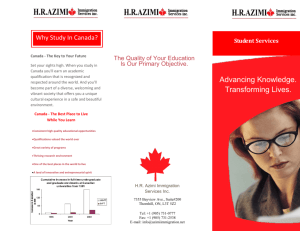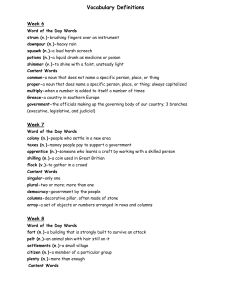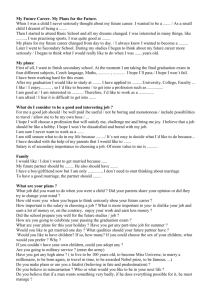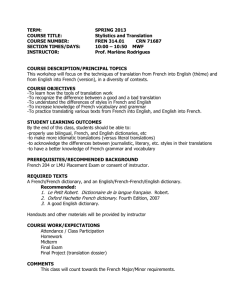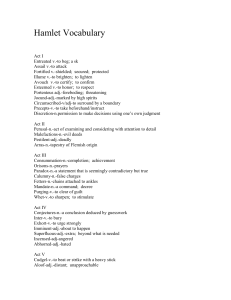Course Syllabus Feel the Music 5 Primary Education
advertisement
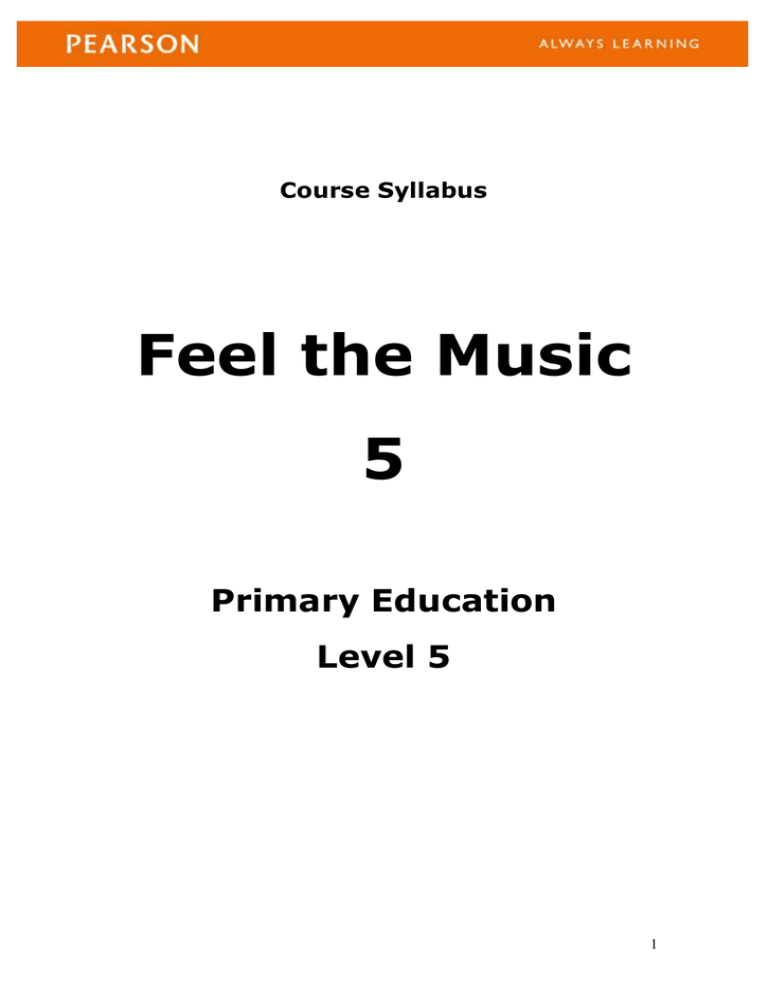
Course Syllabus Feel the Music 5 Primary Education Level 5 1 Unit 1. The Origin of Music and the Middle Ages Justification To learn, identify and define the origin of music and how it developed until the Middle Ages. Objectives *To *To *To *To *To *To *To *To *To *To *To *To *To *To *To *To read and extract specific information. answer questions on a text correctly and coherently. identify and define the origin of music. identify the different kinds of music that emerged in the Middle Ages. follow instructions and learn a medieval dance. revise and name the musical signs and their corresponding rest signs. identify and define the concept of anacrusis correctly. distinguish between melody, harmony and rhythm. practise and play the notes Re/D, Sol/G, La/A, Si/B, Do’/C’ and Re’/D’. follow a simple music score and play the recorder correctly. memorize and sing a song correctly. recognize the importance of traditional music and songs. identify and name the people who influenced music in the Middle Ages. identify and name the instruments played in the Middle Ages. identify and explain the unit content correctly and coherently. show interest in learning about the history of music. Contents Listening Medieval music: Ballad and Salterello Medieval dance music. The notes Re/D, Mi/E, Sol/G, La/A, Si/B, Do’/C’ and Re/D Count Olinos’ Romance Profane music: Canon and Madrigal Religious music: Gregorian Chant, Conductus, Motet and Polyphonic Mass Interpretation and Creation The musical signs semibreve, half (minim), crotchet, quaver, semiquaver and their rests The anacrusis Melody, harmony and rhythm Recorder: Re/D, Mi/E, Sol/G, La/A, Si/B, Do’/C’ and Re/D The Count Olinos’ Romance Unit song: Hey, Diddle, Diddle 2 Basic Competences Cultural and Artistic Competences -To define the origin of music correctly and coherently. -To identify and define the importance of music in the Middle Ages. Linguistic Competences -To read and extract specific information from written and oral texts. -To ask and answer questions on a text correctly. -To memorize and sing a song correctly. -To sing with the correct pronunciation, rhythm and intonation. Social and citizenship Competences -To promote and use the appropriate social norms in personal relationships and group activities. Information and Digital Competences -To develop and use techniques to extract specific information from a written or oral text by observing the information depicted in the illustrations or listening to a CD recording. Mathematical Competences -To use mathematical reasoning to understand the stave, the position of the notes and the equivalents between the musical signs and their rests. Learning How to Learn -To identify one’s own possibilities and shortcomings in music and communicating in the English language and develop autonomous strategies to improve them. Evaluation Criteria *Reads and extracts specific information. *Answers questions on a text correctly and coherently. *Identifies and defines the origin of music. *Identifies the different kinds of music that emerged in the Middle Ages. *Follows instructions and learns a medieval dance. *Revises and names the musical signs and their corresponding rest signs. *Identifies and defines the concept of anacrusis correctly. *Distinguishes between melody, harmony and rhythm. *Practises and plays the notes Re/D, Sol/G, La/A, Si/B, Do’/C’ and Re’/D’. *Follows a simple music score and plays the recorder correctly. *Memorizes and sings a song correctly. *Recognizes the importance of traditional music and songs. *Identifies and names the people who influenced music in the Middle Ages. *Identifies and names the instruments played in the Middle Ages. *Identifies and explains the unit content correctly and coherently. *Shows interest in learning about the history of music. ………………………………………………………………………………………….. 3 Unit 2. The Renaissance Period Justification To learn, identify and define the characteristics of music and dance in the Renaissance period. Objectives *To read and extract specific information. *To answer questions on a text correctly and coherently. *To identify the characteristics of music in the Renaissance Period. *To follow instructions and learn a new dance. *To define the musical scale correctly. *To describe how we use additional or ledger lines correctly and coherently. *To follow a simple music score and practise playing the scales. *To define the flute in the Renaissance Period. *To play a traditional Christmas carol. *To memorize and sing a song correctly. *To revise and use breathing techniques correctly. *To show interest in learning about the people who influenced music in the Renaissance Period. *To identify and name the instruments played in the Renaissance Period. *To identify and explain the unit content correctly and coherently. *To show interest in learning about the history of music. Contents Listening The Renaissance: profane and religious music. Spanish Pavanne, the Galliard Dance music from around the world. The musical scale Traditional Christmas Carol Profane music: Canon and Madrigal Religious music: Mass, Motet Interpretation and Creation The treble clef, time signatures, repetition dots, bar and double bar lines on the stave. The musical scale Additional or ledger lines Reading musical scores. The recorder: Mi/E, Fa/F, Sol/G, La/A, Si/B, Do’/C’ Traditional Christmas carol Unit song: Dancing at the Castle 4 Basic Competences Linguistic Competences -To read and extract specific information from written and oral texts. -To ask and answer questions on a text correctly. -To memorize and sing a song correctly. -To sing with the correct pronunciation, rhythm and intonation. Information and Digital Competences -To develop and use techniques to extract specific information from a written or oral text by observing the information depicted in the illustrations or listening to a CD recording. Social and citizenship Competences -To promote and use the appropriate social norms in personal relationships, dances and group activities. Cultural and Artistic Competences -To appreciate the importance of music and dancing as a cultural patrimony and as an important source for learning and enjoyment. -To define the importance of the Renaissance Period correctly and coherently. -To identify and define the importance of profane and religious music in the Renaissance Period. Autonomous learning competencies -To develop and use reading and listening skills. Evaluation Criteria *Reads and extracts specific information. *Answers questions on a text correctly and coherently. *Identifies the characteristics of music in the Renaissance Period. *Follows instructions and learns a new dance. *Defines the musical scale correctly. *Describes how we use additional or ledger lines correctly and coherently. *Follows a simple music score and practises playing the scales. *Defines the flute in the Renaissance Period. *Plays a traditional Christmas carol. *Memorizes and sings a song correctly. *Revises and uses breathing techniques correctly. *Shows interest in learning about the people who influenced music in the Renaissance Period. *Identifies and names the instruments played in the Renaissance Period. *Identifies and explains the unit content correctly and coherently. *Shows interest in learning about the history of music. ………………………………………………………………………………………………………………………. 5 Unit 3. The Baroque Period Justification -To learn and appreciate the Baroque period and define its different styles of music and dances. Objectives *To read and extract specific information. *To answer questions on a text correctly and coherently. *To identify the Baroque Period in history. *To follow instructions and learn to dance the minuet. *To identify and define the dot, the tie and the pause or fermata. *To follow a simple music score and practise a rhythm taking into account the dot, the ties and pauses. *To listen and identify the timbre of different instruments. *To define the flute in the Baroque Period. *To play a minuet on the recorder. *To memorize and sing a song correctly. *To show interest in learning about the people who influenced music in the Baroque Period. *To identify and name the instruments played in the Baroque Period. *To identify and explain the unit content correctly and coherently. *To show interest in learning about the history of music. Contents Listening Baroque music: Minuet and Giga Dance music in the Baroque period The notes Do/C, re/D, Mi/E, Fa/F, Sol/G, La/A, Si/B, Do’/C’ Fugue, Theme with variations, Suite, Tocata and Sonata, Concert and Concerto Grosso Interpretation and Creation The dot, tie and pause or fermata The recorder: the notes Do/C, re/D, Mi/E, Fa/F, Sol/G, La/A, Si/B, Do’/C’ Reading a music score. The Minuet Unit song: On This Autumn Day Basic Competences Cultural and Artistic Competences -To define the importance of the Baroque Period correctly and coherently. -To identify and define the changes in profane and religious music in the Baroque Period. 6 Social and citizenship Competences -To promote and use the appropriate social norms in personal relationships and group activities. Linguistic Competences -To build on and use the language acquired in reading and singing activities as a means of expressing thoughts, feelings, ideas and opinions. -To read and extract specific information. -To ask and answer questions on a text correctly. Mathematical Competences -Ability to use mathematical reasoning to understand the stave, the position of the notes, tempo, rhythms, etc. Knowledge and Interaction with the Physical World -To appreciate the importance of the movement and expressive possibilities of one’s own body in the surrounding environment. Autonomous learning competences - To use the recreational aspect of music and language learning to consolidate vocabulary, pronunciation, intonation and rhythm. Evaluation Criteria *Reads and extracts specific information. *Answers questions on a text correctly and coherently. *Identifies the Baroque Period in history. *Follows instructions and learns to dance the minuet. *Identifies and defines the dot, the tie and the pause or fermata. *Follows a simple music score and practises a rhythm taking into account the dot, the ties and pauses. *Listens and identifies the timbre of different instruments. *Defines the flute in the Baroque Period. *Plays a minuet on the recorder. *Memorizes and sings a song correctly. *Shows interest in learning about the people who influenced music in the Baroque Period. *To identify and name the instruments played in the Baroque period. *Identifies and explains the unit content correctly and coherently. *Shows interest in learning about the history of music. …………………………………………………………………………………………………………. 7 Unit 4. The Classical Period Justification To appreciate, identify and define the characteristics of music and dance in the Classical period. Objectives *To read and extract specific information. *To answer questions on a text correctly and coherently. *To identify the Classical Period in history. *To follow instructions and learn to dance free movements. *To define the recorder in the Classical Period. *To identify and define the interval on a music score. *To identify the tones and semitones on a music score. *To follow a simple music score and play a traditional melody. *To memorize and sing a song correctly. *To show interest in learning about the people who influenced music in the Classical Period. *To identify and name the instruments played in the Classical Period. *To identify and explain the unit content correctly and coherently. *To show interest in learning about the history of music. Contents Listening Dance music in the Classical period Free movements: Symphony No. 40 by Mozart The notes Do/C, Re/D, Mi/E, Fa/F, Sol/G and La/A Classical music: Sonata, Symphony, Rondo (Round) Interpretation and Creation The interval Ascending and descending scales The C Major or diatonic scale The recorder: the notes Do/C, Re/D, Mi/E, Fa/F, Sol/G and La/A Reading a music score Twinkle, Twinkle, Little Star Unit song: One Sunny, Sunday Morning Basic Competences Cultural and Artistic Competences -To define the importance of the Classical Period correctly and coherently. -To identify and define the evolution in music in the Classical Period. 8 Knowledge and Interaction with the Physical World -To appreciate the importance of the movement and expressive possibilities of one’s own body and adapt them to the surrounding environment. Mathematical Competences -To use mathematical reasoning to understand the stave, the position of the notes and the equivalents between the musical signs and their rests. Linguistic Competences -To build on and use the language acquired in reading and singing activities as a means to improving one’s own communication competences. -To read and extract specific information from a written and oral text. -To ask and answer questions on a text correctly. Autonomy and personal initiative To take responsibility for his/her own work, to evaluate his/her own progress in the music and language learning process, identify mistakes and correct them. Social and citizenship competences -To respect the physical and intellectual differences amongst classmates and help those with less capacity than themselves. - To acknowledge and use the appropriate social norms when participating in group activities. Cultural and Artistic Competences -To appreciate the importance of musical and artistic manifestations throughout history as an important source for learning and enjoyment. Autonomous learning competences -To use autonomous learning strategies to organize the concepts presented and complete the activities proposed. Evaluation Criteria *Reads and extracts specific information. *Answers questions on a text correctly and coherently. *Identifies the Classical Period in history. *Follows instructions and learns to dance free movements. *Identifies and defines the interval on a music score. *Identifies the tones and semitones on a music score. *Defines the flute in the Classical Period. *Follows a simple music score and plays a traditional melody. *Memorizes and sings a song correctly. *Shows interest in learning about the people who influenced music in the Classical Period. *Identifies and names the instruments played in the Classical period. *Identifies and explains the unit content correctly and coherently. *Shows interest in learning about the history of music. …………………………………………………………………………………………………….. 9 Unit 5. The Romantic Period I Justification -To appreciate, identify and define the characteristics of music and dance in the Romantic period I. Objectives *To read and extract specific information. *To answer questions on a text correctly and coherently. *To identify the Romantic Period in history. -To enjoy listening to Classical music. *To follow instructions and learn a regional dance. *To identify and define the accidentals and how they are used. *To identify and define the dynamic marks or performance directions on a music score. *To play a passage on the recorder taking into account the dynamic marks. *To define the flute in the Romantic Period. *To follow a simple music score and play Ode to Joy. *To memorize and sing a song correctly. -To appreciate the importance of singing as an important source of vocabulary in the language learning process. *To show interest in learning about the people who influenced music in the Romantic Period. *To identify and name the instruments played in the Romantic period. *To identify and explain the unit content correctly and coherently. *To show interest in learning about the history of music. Contents Listening Contra dance and laendler Regional dances The notes Re/D, Sol/G, La/A, Si/B, Do’/C’ and Re/D’ Ode to Joy Music from the Romantic Period: Sonata, Bagatelles, Lied, symphonies and concerts Interpretation and Creation Accidentals: sharp Dynamics or performance directions The recorder: Re/D, Sol/G, La/A, Si/B, Do’/C’ and Re/D’ Ode to Joy Unit song: Tell Me The way to London Town 10 Basic Competences Linguistic Competences -To build on and use the language acquired in reading and singing activities as a means to improving one’s own communicative competences. -To read and extract specific information from a written and oral text. -To ask and answer questions on a text correctly. -To understand and carry out a choreography for a new dance. Knowledge and Interaction with the Physical World -To appreciate the importance of the movement and expressive possibilities of one’s own body in the surrounding environment. Cultural and Artistic Competences -To appreciate the importance of musical and artistic manifestations in the country’s cultural patrimony and as an important source for learning and enjoyment. -To define the importance of the Romantic Period correctly and coherently. Mathematical Competences -To use mathematical reasoning to understand the stave, the position of the notes and the equivalents between the musical signs and their rests. Learning How to Learn Competences -To identify one’s own possibilities and shortcomings in communicating in music and in the English language and develop autonomous strategies to improve them. Social and citizenship competences -To promote and use the appropriate social norms in personal relationships and group activities. Autonomous learning competencies -To use the recreational aspect of music and language learning to consolidate vocabulary, pronunciation, intonation and rhythm. Evaluation Criteria *Reads and extracts specific information. *Answers questions on a text correctly and coherently. *Identifies the Romantic Period in history and enjoys listening to music. *Follows instructions and learns a regional dance. *Identifies and defines the accidentals and how they are used. 11 *Identifies and defines the dynamic marks or performance directions on a music score. *Plays a passage on the recorder taking into account the dynamic marks. *Defines the flute in the Romantic Period. *Follows a simple music score and plays Ode to Joy. *Memorizes and sings a song correctly. *Shows interest in learning about the people who influenced music in the Romantic Period. *Identifies and names the instruments played in the Romantic period. *Identifies and explains the unit content correctly and coherently. *Shows interest in learning about the history of music. ……………………………………………………………………………………………………………………………… Unit 6. The Romantic Period II Justification To appreciate, identify and define the characteristics of music and dance in the Romantic period II. Objectives *To read and extract specific information. *To answer questions on a text correctly and coherently. *To identify the second half of the Romantic Period in history. *To follow instructions and learn a choreography. *To identify and define tempo and movement. *To identify and define the signs for changes in dynamic levels. *To define the flute in the second half of the Romantic Period. *To follow a simple music score and play Moon River. *To memorize and sing a song correctly. *To show interest in learning about the people who influenced music in the Romantic Period. *To identify and name the instruments played in the Romantic period II. *To identify and explain the unit content correctly and coherently. *To show interest in learning about the history of music. Contents Listening Dance music from the Romantic period II Choreography: Hungarian dances The notes Do/C, Re/D, Mi/E, Fa/F, Sol/G, La/A, Si/B, Do’/C’ and Re’/D’ Moon River Music from the Romantic Period: Symphony, Concert, Symphonic poem, Overture, Lied, Sonata 12 Interpretation and Creation Tempo Changes in dynamic levels: crescendo y diminuendo Recorder. Do/C, Re/D, Mi/E, Fa/F, Sol/G, La/A, Si/B, Do’/C’ and Re’/D’ Moon River Unit song: Dance with Me Basic Competences Linguistic Competences -To use the language acquired in the music and language learning process as a means to improving one’s own communicative competences. Mathematical Competences -Ability to use mathematical reasoning to understand the position of the notes and the equivalents between the musical signs. Social and citizenship competences -To acknowledge and use the appropriate social norms when participating in group activities. Autonomous learning competencies -To use the recreational aspect of music and language learning to consolidate vocabulary, pronunciation, intonation and rhythm. Learning How to Learn Competences -To identify one’s own possibilities and shortcomings in communicating in music and in the English language and develop autonomous strategies to improve them. Cultural and Artistic Competences -To appreciate the importance of music as a cultural patrimony and as an important source for learning, enjoyment and expressing one’s own feelings in a creative manner. -To define the importance of the Romantic Period correctly and coherently. Autonomy and Personal Initiative -To maintain a responsible attitude and perseverance in one’s own work as a means to achieving self-esteem and self criticism. Evaluation Criteria *Reads and extracts specific information. *Answers questions on a text correctly and coherently. *Identifies the second half of the Romantic Period in history. 13 *Follows instructions and learns a choreography. *Identifies and defines tempo and movement. *Identifies and defines the signs for changes in dynamic levels. *Defines the flute in the second half of the Romantic Period. *Follows a simple music score and plays Moon River. *Memorizes and sings a song correctly. *Shows interest in learning about the people who influenced music in the Romantic Period. *Identifies and names the instruments played in the Romantic Period II. *Identifies and explains the unit content correctly and coherently. *Shows interest in learning about the history of music. 14
